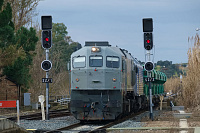For 5G networks, the basic synchronization requirements haven’t changed. For FDD networks (Frequency Division Duplexing), the carrier frequency must be within 50 ppb (parts per billion) of the allocated frequency, while for TDD (Time Division Duplexing), basestations must be synchronized to within 3 microseconds of each other, or to within 1.5 microseconds of a central time reference.
However, that’s not the whole story. There are several radio techniques being proposed for 5G that require much tighter synchronization between local RRUs. One example is inter-site carrier aggregation. This is the ability to bond two separate carrier frequencies together to form a large, high-bandwidth pipe. Carrier aggregation was used extensively by 4G operators to increase data rates to consumers, but the two carrier frequencies were transmitted from the same antenna. For 5G, that might not always be the case – the carriers may be transmitted from separate RRUs. This means the RRUs must be synchronized to within 260ns of each other.
Another example being discussed is MIMO. This uses multiple antennas, normally connected to the same RRU. However, there are proposals in 5G to allow MIMO to be used across different RRUs. This requires even tighter synchronization of less than 65ns difference between RRUs.
Clearly, these techniques require extremely high accuracy from the synchronization network. However, the distinguishing feature is that these are DU functions, therefore the tight synchronization is only required in a cluster consisting of the DU with its connected RRUs. This is shown in the diagram below:

So does that mean operators can simply provide tight synchronization in the small cluster region? Not true according to some operators. They also have to take into account failure conditions and network changes. Networks don’t stay the same for long, they change topology over time, whether through equipment failures or planned additions or re-configurations. This means it can be hard to keep track of the synchronization relationships between elements.
For example, DUs can be multi-homed, meaning they can connect to more than one CU for protection purposes. Similarly, it may not always be clear which DU an RRU is connected to. Therefore some operators have stated that they want the cluster limit to apply to the entire network. That way they are certain that whatever network changes or re-configurations occur, the synchronization requirements are always met.
Tim Frost
Strategic Technology Manager, Calnex Solutions.






































































